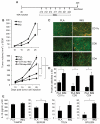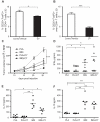Synergy of topical toll-like receptor 7 agonist with radiation and low-dose cyclophosphamide in a mouse model of cutaneous breast cancer
- PMID: 23048078
- PMCID: PMC3525760
- DOI: 10.1158/1078-0432.CCR-12-0984
Synergy of topical toll-like receptor 7 agonist with radiation and low-dose cyclophosphamide in a mouse model of cutaneous breast cancer
Abstract
Purpose: This study tested the hypothesis that topical Toll-like receptor (TLR) 7 agonist imiquimod promotes antitumor immunity and synergizes with other treatments in a model of skin-involving breast cancer.
Experimental design: TSA mouse breast carcinoma cells were injected s.c. into syngeneic mice. Imiquimod 5% or placebo cream was applied topically on the shaved skin overlying tumors three times/wk. In some experiments, local ionizing radiation therapy (RT) was delivered to the tumor in three fractions of 8 Gy, given on consecutive days. Cyclophosphamide was given intraperitoneally (i.p.) in one dose of 2 mg/mouse. Mice were followed for tumor growth and survival.
Results: Treatment with imiquimod significantly inhibited tumor growth, an effect that was associated with increased tumor infiltration by CD11c(+), CD4(+), and CD8(+) cells, and abolished by depletion of CD8(+) cells. Administration of imiquimod in combination with RT enhanced significantly tumor response compared with either treatment alone (P < 0.005), and 11% to 66% of irradiated tumors completely regressed. Importantly, the addition of topical imiquimod also resulted in growth inhibition of a secondary tumor outside of the radiation field. Low-dose cyclophosphamide given before start of treatment with imiquimod and RT further improved tumor inhibition and reduced tumor recurrence. Mice that remained tumor-free rejected a tumorigenic inoculum of TSA cells, showing long-term immunologic memory.
Conclusions: Topical imiquimod inhibits tumor growth and synergizes with RT. Addition of cyclophosphamide further increases the therapeutic effect and induces protective immunologic memory, suggesting that this combination is a promising strategy for cutaneous breast cancer metastases.
2012 AACR.
Figures






Comment in
-
Breast cancer treatment with imiquimod: applying an old lotion to a new disease.Clin Cancer Res. 2012 Dec 15;18(24):6571-3. doi: 10.1158/1078-0432.CCR-12-3138. Epub 2012 Nov 21. Clin Cancer Res. 2012. PMID: 23172886
References
-
- Lookingbill DP, Spangler N, Helm KF. Cutaneous metastases in patients with metastatic carcinoma: a retrospective study of 4020 patients. J Am Acad Dermatol. 1993;29:228–36. - PubMed
-
- Krathen RA, Orengo IF, Rosen T. Cutaneous metastasis: a meta-analysis of data. South Med J. 2003;96:164–7. - PubMed
-
- Cheever MA. Twelve immunotherapy drugs that could cure cancers. Immunol Rev. 2008;222:357–68. - PubMed
-
- Geisse J, Caro I, Lindholm J, Golitz L, Stampone P, Owens M. Imiquimod 5% cream for the treatment of superficial basal cell carcinoma: results from two phase III, randomized, vehicle-controlled studies. J Am Acad Dermatol. 2004;50:722–33. - PubMed
MeSH terms
Substances
Grants and funding
LinkOut - more resources
Full Text Sources
Other Literature Sources
Medical
Research Materials
Miscellaneous

